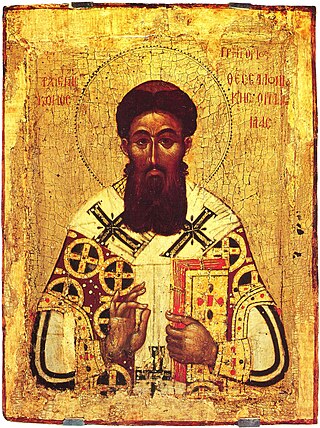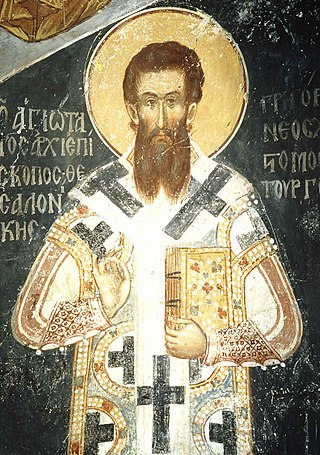Related Research Articles

Hesychasm is a contemplative monastic tradition in the Eastern Christian traditions of the Eastern Catholic Church and Eastern Orthodox Church in which stillness (hēsychia) is sought through uninterrupted Jesus prayer. While rooted in early Christian monasticism, it took its definitive form in the 14th century at Mount Athos.

Polycarp was a Christian bishop of Smyrna. According to the Martyrdom of Polycarp, he died a martyr, bound and burned at the stake, then stabbed when the fire failed to consume his body. Polycarp is regarded as a saint and Church Father in the Catholic, Eastern Orthodox, Oriental Orthodox, Anglican, and Lutheran churches.

Gregory Palamas was a Byzantine Greek theologian and Eastern Orthodox cleric of the late Byzantine period. A monk of Mount Athos and later archbishop of Thessaloniki, he is famous for his defense of hesychast spirituality, the uncreated character of the light of the Transfiguration, and the distinction between God's essence and energies. His teaching unfolded over the course of three major controversies, (1) with the Italo-Greek Barlaam between 1336 and 1341, (2) with the monk Gregory Akindynos between 1341 and 1347, and (3) with the philosopher Gregoras, from 1348 to 1355. His theological contributions are sometimes referred to as Palamism, and his followers as Palamites.

Maximus the Confessor, also spelled Maximos, otherwise known as Maximus the Theologian and Maximus of Constantinople, was a Christian monk, theologian, and scholar.
The Philokalia is "a collection of texts written between the 4th and 15th centuries by spiritual masters" of the mystical hesychast tradition of the Eastern Orthodox Church. They were originally written for the guidance and instruction of monks in "the practice of the contemplative life". The collection was compiled in the 18th century by Nicodemus the Hagiorite and Macarius of Corinth based on the codices 472, 605, 476, 628 and 629 from the library of the monastery of Vatopedi, Mount Athos.
The Apostolic Fathers, also known as the Ante-Nicene Fathers, were core Christian theologians among the Church Fathers who lived in the 1st and 2nd centuries AD who are believed to have personally known some of the Twelve Apostles or to have been significantly influenced by them. Their writings, though widely circulated in early Christianity, were not included in the canon of the New Testament. Many of the writings derive from the same time period and geographical location as other works of early Christian literature which came to be part of the New Testament.

Saint Nilus the Elder of Sinai was one of the many disciples and stalwart defenders of St. John Chrysostom.

The Byzantine calendar, also called the Roman calendar, the Creation Era of Constantinople or the Era of the World, was the calendar used by the Eastern Orthodox Church from c. 691 to 1728 in the Ecumenical Patriarchate. It was also the official calendar of the Byzantine Empire from 988 to 1453 and of Kievan Rus' and Russia from c. 988 to 1700. This calendar was used also in other areas of the Byzantine commonwealth such as in Serbia, where it is found in old Serbian legal documents such as Dušan's Code, thus being referred to as the Serbian Calendar as well.
Gerald Eustace Howell Palmer was a United Kingdom author, book translator, and Conservative Party politician. Palmer's work in translating the Philokalia, an Eastern Orthodox spiritual text, is still recognised in modern times with the popularity of that book.
Gregory of Sinai, or in Serbian and Bulgarian Grigorije Sinaita, was a Greek Christian monk and writer from Smyrna. He was instrumental in the emergence of hesychasm on Mount Athos in the early 14th century.
Neoplatonism was a major influence on Christian theology throughout Late Antiquity and the Middle Ages in the East, and sometimes in the West as well. In the East, major Greek Fathers like Basil, Gregory of Nyssa and Gregory of Nazianzus were influenced by Platonism and Neoplatonism, but also Stoicism often leading towards asceticism and harsh treatment of the body, for example stylite asceticism. In the West, St. Augustine of Hippo was influenced by the early Neoplatonists Plotinus and Porphyry. Later on, in the East, the works of the Christian writer Pseudo-Dionysius the Areopagite, who was influenced by later Neoplatonists such as Proclus and Damascius, became a critical work on which Greek church fathers based their theology, like Maximus believing it was an original work of Dionysius the Areopagite.

Marcus Eremita, Mark the Ascetic or Marcus the Ascetic was a Christian theologian, saint, and ascetic writer of the fifth century AD.

Niketas Stethatos was a Byzantine mystic and theologian who is considered a saint by the Eastern Orthodox Church. He was a follower of Symeon the New Theologian and wrote the most complete biography of Symeon, Life of Symeon.

Aerial toll houses are a belief held by some in the Eastern Orthodox Church which states that "following a person's death the soul leaves the body, and is escorted to God by angels. During this journey the soul passes through an aerial realm, which is inhabited by wicked spirits. The soul encounters these demons at various points referred to as toll-houses where the demons then attempt to accuse it of sin and, if possible, drag the soul into hell."

The Church Fathers, Early Church Fathers, Christian Fathers, or Fathers of the Church were ancient and influential Christian theologians and writers who established the intellectual and doctrinal foundations of Christianity. The historical period in which they worked became known as the Patristic Era and spans approximately from the late 1st to mid-8th centuries, flourishing in particular during the 4th and 5th centuries, when Christianity was in the process of establishing itself as the state church of the Roman Empire.
Theoleptos of Philadelphia was a Byzantine monk, Metropolitan of Philadelphia (1283/4–1322) and Eastern Orthodox theologian.
Nikephoros the Monk, also called the Hesychast or the Athonite, was a 13th-century monk and spiritual writer of the Eastern Orthodox Church. According to Gregory Palamas, Nikephoros was originally a Roman Catholic but travelled to the Byzantine Empire, where he converted to the Eastern Orthodox faith and became a monk at Mount Athos. Like Theoleptos of Philadelphia, Nikephoros was a strong opponent of the union of the Eastern Orthodox and Roman Catholic Churches which was agreed to at the Council of Lyons in 1274. Because of this, he was imprisoned and later wrote an account of his ordeal.
Isaiah the Solitary, also known as Isaiah of Gaza, Isaias the Solitary, Abba Isaiah, or possibly also Isaiah of Scetis, was a Christian ascetic and monastic writer known from the Sayings of the Desert Fathers and various Palestinian Miaphysite sources. He is canonized as a saint by the Coptic Orthodox Church, with his feast day on the 11th day of the month Abib (Epip) in the Coptic calendar.
Philotheus of Sinai was a Christian monk and writer who lived in Egypt. He lived sometime before 1100 – most likely during the 9th century, or possibly the 10th century. Very little is known about his life.

Peter of Damascus or Peter Damascene was an Eastern Christian monastic, theologian, and Church Father who lived in the 12th century. He is notable for being the second most voluminous author in the Philokalia.
References
- ↑ "Instructions of Presbyter Elias". Orthodox Photos, Monasteries, Fathers, Elders. Retrieved 2022-08-20.
- 1 2 Palmer, G. E. H.; Ware, Kallistos; Sherrard, Philip (1986). The Philokalia: The Complete Text. Vol. 3. Faber and Faber. ISBN 0-571-17525-2.
- ↑ "Ilias the Presbyter: A Gnomic Anthology". Orthodox Church Fathers. Retrieved 2022-08-20.